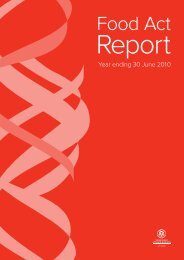Public Health and Communicable Diseases - SA Health - SA.Gov.au
Public Health and Communicable Diseases - SA Health - SA.Gov.au
Public Health and Communicable Diseases - SA Health - SA.Gov.au
Create successful ePaper yourself
Turn your PDF publications into a flip-book with our unique Google optimized e-Paper software.
While ongoing monitoring <strong>and</strong> analysis over a longertime period is required to confirm changes in utilisationrates, some trends in usage of individual antimicrobialclasses <strong>and</strong> agents within classes are evident.Intervention programs to modify prescribing patternsfor classes linked to the emergence of multi-resistantspecies <strong>and</strong> other organisms, such as Clostridiumdifficile, should be considered a priority for all SouthAustralian hospitals.References1. Haley RW. The scientific basis for using surveillance<strong>and</strong> risk factor data to reduce nosocomialinfection rates. Journal of Hospital Infection.1995;30(Supplement):3-14.2. An Expert Working Group of the Australian InfectionControl Association. Blood Stream Infection (BSI)Definition. National Surveillance of <strong>Health</strong>careAssociated Infection in Australia. Approved by<strong>Health</strong>care Associated Infections Advisory Committeeof Safety <strong>and</strong> Quality–Sept 04. Available from: http://www.safety<strong>and</strong>quality.org/index.cfm?page=Action#suvlncdefine3. Bartlett J, Perl T. The New Clostridium difficile - WhatDoes It Mean? New Engl<strong>and</strong> Journal of Medicine.2005;353(23):2503-5.For further information regarding either definitions usedor information discussed in this report please refer tothe “Definitions” section of the Infection Control Servicewebsite. http://www.healthsa.sa.gov.<strong>au</strong>/infectioncontrol/<strong>Communicable</strong> DiseaseControl Branch Report– 01 July to 31 December 2005VECTORBORNE DISEASESRoss River virusThere were 64 cases reported during this period. A totalof 57 cases were notified in 2004 (26 males, 38 females,age range: 8 to 85 years). The majority of cases eitherresided in or reported recent travel to the Riverl<strong>and</strong>,South-East <strong>and</strong> Far North of South Australia.The last major outbreak of Ross River virus infections inSouth Australia occurred during the summer of 2000-2001. Figure 1 (see below) illustrates 3 to 4 yearly cyclicincreases in the number of cases of Ross River virusinfection.Barmah Forest virusIn the period under review, 15 cases of Barmah Forestvirus infection were reported. A total of four cases werereported for the same period in 2004. Of the 15 cases,ten (67%) either resided in or reported travel to ruralSouth Australia.An epidemic curve <strong>and</strong> source map illustrating RossRiver virus activity in South Australia can be viewedon our web site: http://www.health.sa.gov.<strong>au</strong>/pehs/.Information on preventing vector borne diseases <strong>and</strong>Fight the Bite campaign can also be obtained by visitingthis website.Dengue feverThere were three reports of dengue fever in people whoreported recent travel to Asia (one male, two females,age range: 14 to 45 years).40
















